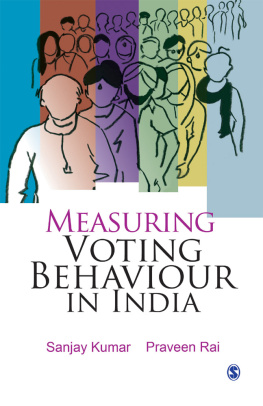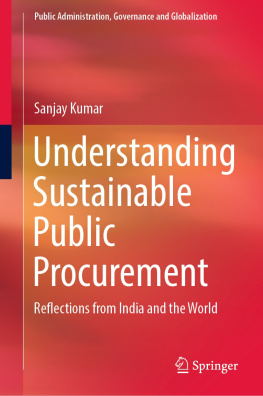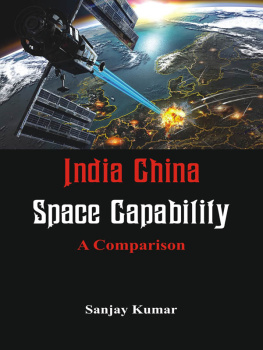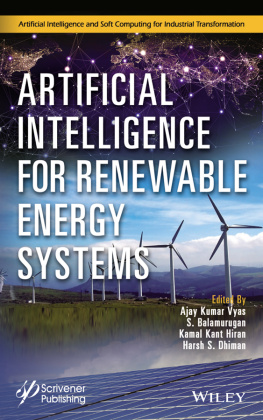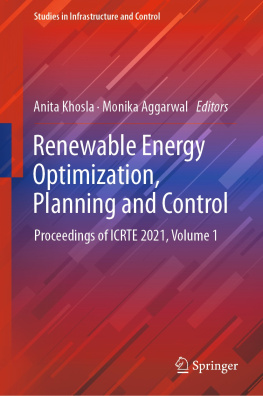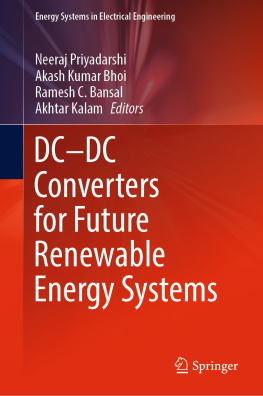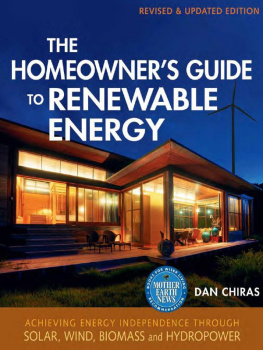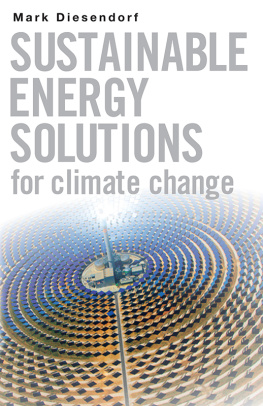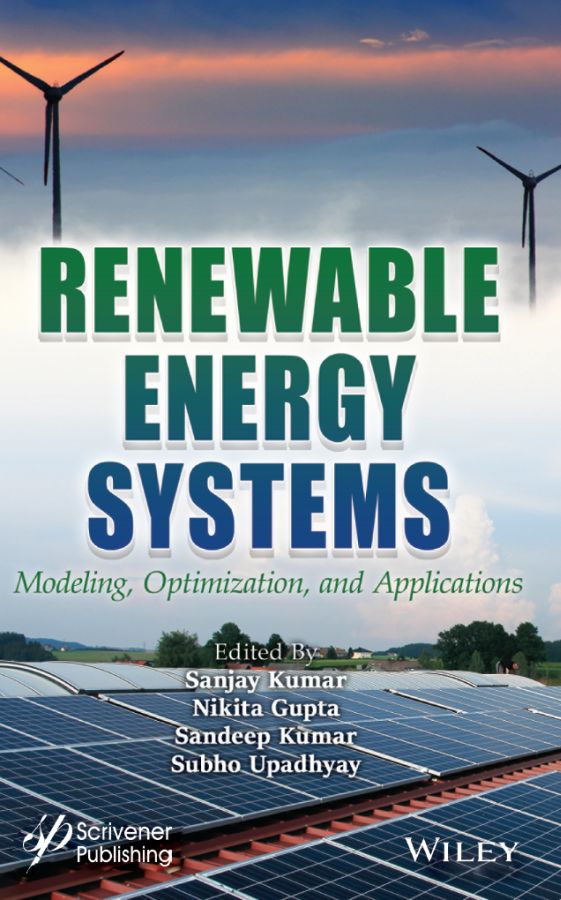
Scrivener Publishing
100 Cummings Center, Suite 541J
Beverly, MA 01915-6106
Publishers at Scrivener
Martin Scrivener ()
Phillip Carmical ()
Renewable Energy Systems
Modeling, Optimization and Applications
Edited by
Sanjay Kumar
Nikita Gupta
Sandeep Kumar
and
Subho Upadhyay

This edition first published 2022 by John Wiley & Sons, Inc., 111 River Street, Hoboken, NJ 07030, USA and Scrivener Publishing LLC, 100 Cummings Center, Suite 541J, Beverly, MA 01915, USA
2022 Scrivener Publishing LLC
For more information about Scrivener publications please visit www.scrivenerpublishing.com.
All rights reserved. No part of this publication may be reproduced, stored in a retrieval system, or transmitted, in any form or by any means, electronic, mechanical, photocopying, recording, or otherwise, except as permitted by law. Advice on how to obtain permission to reuse material from this title is available at http://www.wiley.com/go/permissions.
Wiley Global Headquarters
111 River Street, Hoboken, NJ 07030, USA
For details of our global editorial offices, customer services, and more information about Wiley products visit us at www.wiley.com.
Limit of Liability/Disclaimer of Warranty
While the publisher and authors have used their best efforts in preparing this work, they make no representations or warranties with respect to the accuracy or completeness of the contents of this work and specifically disclaim all warranties, including without limitation any implied warranties of merchantability or fitness for a particular purpose. No warranty may be created or extended by sales representatives, written sales materials, or promotional statements for this work. The fact that an organization, website, or product is referred to in this work as a citation and/or potential source of further information does not mean that the publisher and authors endorse the information or services the organization, website, or product may provide or recommendations it may make. This work is sold with the understanding that the publisher is not engaged in rendering professional services. The advice and strategies contained herein may not be suitable for your situation. You should consult with a specialist where appropriate. Neither the publisher nor authors shall be liable for any loss of profit or any other commercial damages, including but not limited to special, incidental, consequential, or other damages. Further, readers should be aware that websites listed in this work may have changed or disappeared between when this work was written and when it is read.
Library of Congress Cataloging-in-Publication Data
ISBN 9781119803515
Cover image: Pixabay.com
Cover design by Russell Richardson
Set in size of 11pt and Minion Pro by Manila Typesetting Company, Makati, Philippines
Printed in the USA
10 9 8 7 6 5 4 3 2 1
Importance of Hybrid Energy System in Reducing Greenhouse Emissions
Rupan Das, Somudeep Bhattacharjee and Uttara Das
Department of Electrical Engineering, Tripura University, Agartala, India
Abstract
According to the current situation, certain undeveloped world areas are electrified, but with contamination-generating energy sources. In contrast to individual renewable energy sources, contamination-generating energy sources have the advantage of providing a consistent supply of electricity. As a result, they are used in a variety of locations around the world. The majority of these locations have the potential to generate renewable energy. Renewable resources, on the other hand, are irregular. As a result, the only alternative for replacing these polluting energy sources is a hybrid system based on renewable energy. Because a hybrid system produces electricity from different energy sources, it helps to ensure power supply reliability. Accordingly, this chapter contains a detailed discussion about environmental change. Moreover, it discusses the concept of a hybrid system and its role in minimizing the dangerous impacts of environmental change. In this chapter, a grid-connected solar-wind-diesel generator-based hybrid energy framework is developed. The hybrid energy system that is designed here gives more significance to the AC (Alternating Current) generation; however, DC (Direct Current) also comes into the act. Under all the operating conditions for meeting the load demand, the hybrid energy system has been designed to provide the output power at its maximum level. A diesel generator was connected to support the uninterrupted supply in load power if one of these two generation systems were to fail, and it works as a backup supply of power. The proposed hybrid system framework is simulated so that if two energy generation systems fail, then the diesel generator and grid satisfy the load demand. The simulation results show that this grid- connected renewable energy-based hybrid model successfully solved power generation utilizing renewable energy base sources and helps reduce pollution.
Keywords: Climate change, hybrid framework, integrated energy technologies, wind energy system, solar PV system
1.1 Introduction
Electricity generation by fossil fuel becomes more problematic due to lack of their resources. The burning of non-conventional resources increases greenhouse gases and is the leading cause of global warming. To mitigate this problem of global warming through power generation, renewable sources like solar, hydro, wind, biomass, etc., can easily be used. However, renewable sources also have some drawbacks, such as the lack of availability of solar power at night, the wind is very fluctuating in nature, also water is not sufficiently available during summer, and fuel is insufficient for biomass energy. But the individual disadvantages of renewable energy sources can be easily overcome using a hybrid energy framework. A hybrid energy framework also is an excellent solution to minimize greenhouse gases in urban areas and also rural areas with shorter construction time, low-cost and heavy accurate response to load, low emission [13]. This forces people to shift their interest towards grid-connected hybrid energy systems from non-renewable energy generation systems. The power generation capacity based on renewable energy comprises 12.6% of the total installed capacity in India for the generation of power. Indias total renewable energy installed capacity is 25,410 MW, where 70% comes from wind [4], 13% from hydro, 13% from solar, 4% from biomass. Different renewable energy of India contains different capacity factors; hydro has 35%-40%, wind has 25%-30%, and solar has 17% capacity factor [4].
According to the current reality, certain untouched places around the world are electrified using contamination-creating energy sources. Because contamination-producing energy sources have the advantage of ensuring a constant supply of electricity, they are used more widely over the world than individual renewable energy sources. However, this contamination-related energy generation has hazardous effects on global warming. Global warming, climate change, and pollution are the dangers and threats that human society currently faces. This global warming is bringing disturbance to the Earth. It is directly about environmental change [5, 6]. Climate change has recently been a hot topic, as the global climate pattern is fast altering, even day by day. Many objects or practices are utilized in the technical area that negatively impact our environment, such as using non-renewable energy sources, greenhouse gas emissions, etc. So, to deal with such disruption, we have to think about alternative energy production. In debates about sustainable development, one of the key elements is energy. As the worlds energy consumption peaks, energy conservation becomes a global priority. Electricity is one of the most important aspects and fundamental parts of our day-to-day life from all types of energy. With the increase in population all around the globe, the demand for electricity is increased. Then the question is all about how to generate clean and green energy [7, 8]. Given that the present convention of generating electricity across the globe is generally from non-conventional resources, more utilization of renewable energy sources is required to address these issues through power generation. Renewable energy resources are now one of the most promising options to address various difficulties since 1970 when significant companies worldwide faced a petroleum shortage and other crises. Environmental change, desertification, nursery impact, etc., are leading the world towards the renewable energy era. Another primary reason to look for alternate resources is that non-renewable sources are ecologically threatening. An Earth-wide temperature boost and large amounts of CO2 (Carbon Dioxide) in the environment have constrained us to think about the alternative for these resources [9]. Utilizing natural and renewable resources such as solar, wind, wave, hydroelectric, geothermal, and tidal provide clean alternatives to non-renewable energy sources since they are ubiquitous, free, abundant, clean, and easily accessible, even in remote, untouched locations. Because of their commercial acceptance and technological maturity, solar and wind energy have risen to the top of the list. Furthermore, it is better to discover those places in the world that have the possibility of renewable power generation and use it for renewable power generation [11]. The majority of these locations have renewable energy-producing capabilities. Therefore, the sole option for minimizing environmental change is to use a hybrid system based on renewable energy to replace these polluting energy sources [12, 13].
Next page

